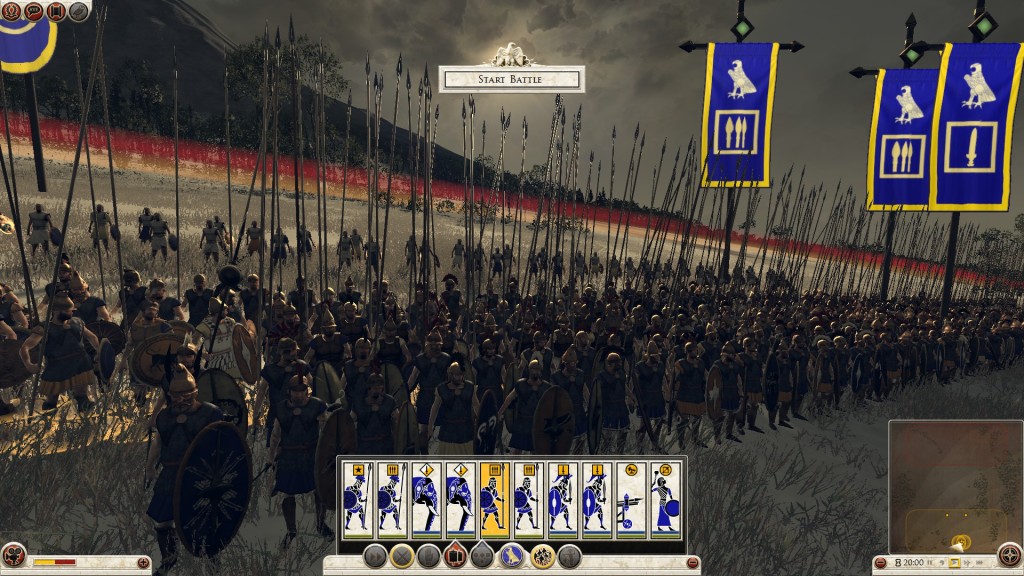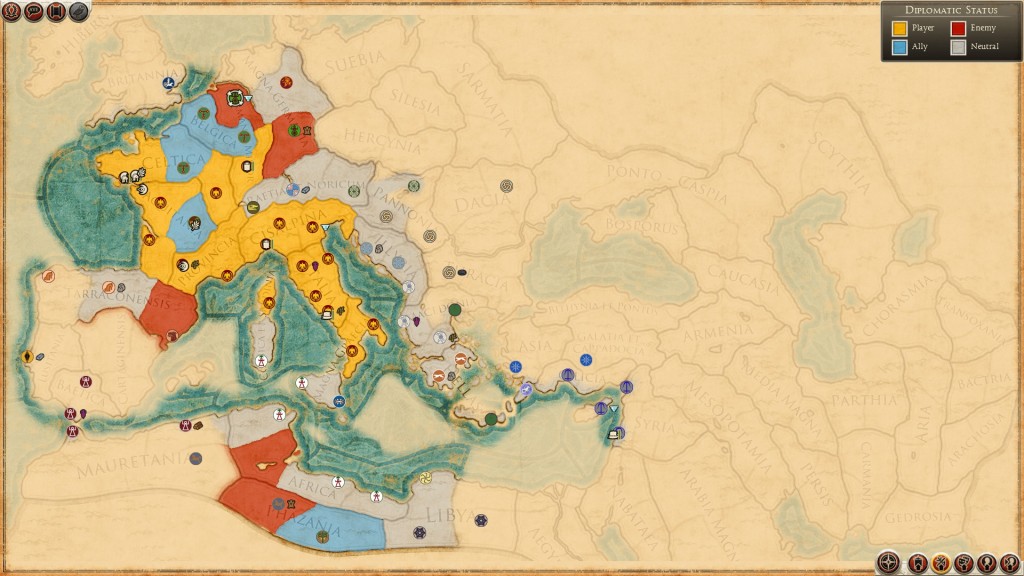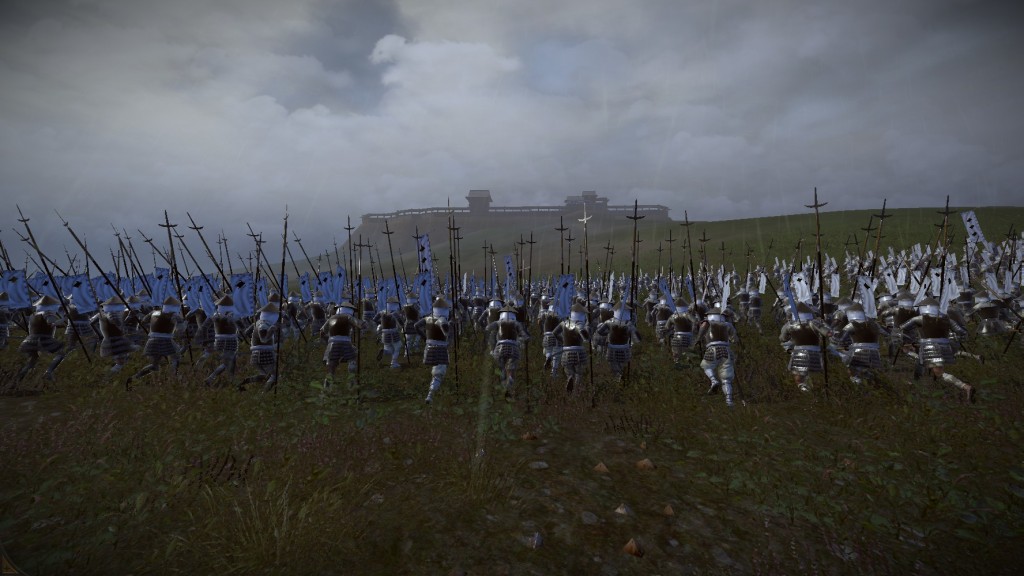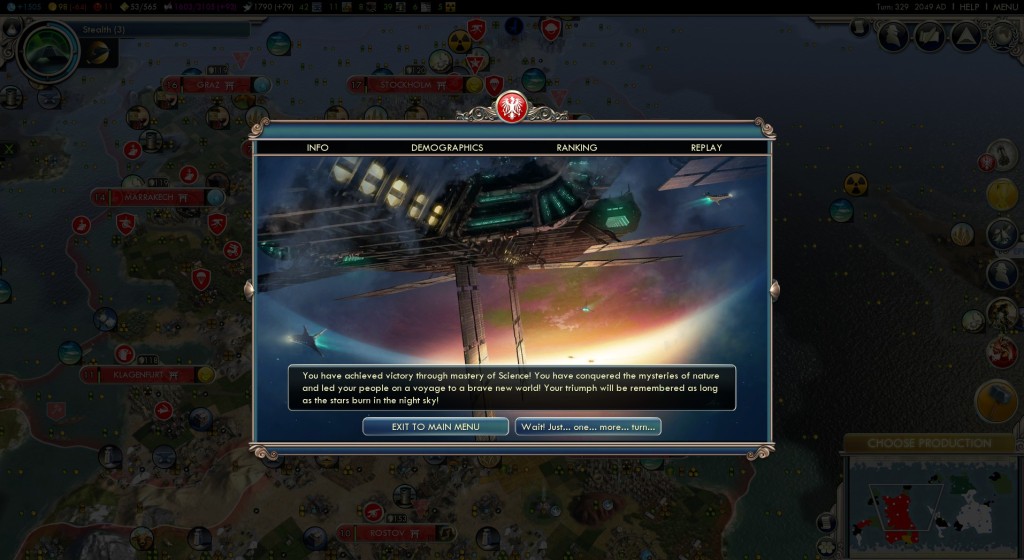This is not a review of Creative Assembly’s Total War: Rome II, but if it were, my opinion would be, “Worth a look… but wait for the <$10 Steam sale.” I’m around 30 hours into Rome II, spread across two campaigns and multiple stand-alone battles. I’ve had enjoyable times, and some spectacular moments. I’ve thundered elephants through the flank of a distracted foe, raised last-ditch armies, and marched from the Tiber to the English Channel, but the whole of my experience has been less than the sum of its parts. And the really interesting question is why.

As with other Total War games, there are two key parts to Rome II: (a) real-time tactical battles, linked by (b) a turn-based strategic campaign. Total War veterans will be very familiar with the strengths, quirks, and flaws of Rome II’s pre-gunpowder melee combat: it’s spectacular to watch, and when it works, it illustrates the appeal of real-time strategy: cerebral decisions (the “strategy” part), plus the thrill of ordering a manoeuvre at the perfect moment (the “real-time” part). Indeed, Rome II is at its best in custom battle mode (i.e. outside the campaign) (1); it’s as satisfying as ever to anchor a line with good, solid Roman legionaries or Hellenistic pikemen; then unleash the decisive cavalry charge into the enemy’s back. For this alone, it might be worth picking up a cut-price Rome II.
Rome II’s real problems lie in campaign mode. The first few turns, when the player’s empire is small and weak, offer a tense, interesting, cohesive challenge; however, I can’t say the same about the rest of my time with the campaign. Much of this is simply poor execution, most visible in the inept AI; below, I’ve attached a screenshot of my Roman campaign on Hard difficulty (begun during the previous patch – #3), taken at the 69-turn mark. My territory is shown in gold, allies and client states in blue. Note that no other faction visible on the map is even one-third my size (2)! Not only did the computer not expand, it proved unable to muster a proper army; my march to the English Channel was fought against wave after wave of early-game units (3), no match for my Roman legions. 20+ hours into the game and 60 turns into my Roman campaign, a beta of the current patch (#4, meant to improve the campaign AI) came out. After briefly soldiering on, I started a new campaign as Macedon on Hard that proved a bit better, but only a bit. The AI is now more proactive (multiple computer players declared war on me as Macedon, and I also saw them scrapping with each other), and has a better grasp of army composition (4). However, in 29 turns, I faced only one actual invasion attempt, plus one near-miss when a small detachment of Spartan soldiers milled around my border. (I ended up quite literally crushing the Spartans; unsupported by cavalry, their valour couldn’t save them from a rain of ballista stones. The rest was just mopping up.) The contrast with Rome II’s predecessor, the superb Shogun 2 and its cut-throat AI, couldn’t be greater.

Even with perfect execution, though, Rome II’s campaign would not be great. In fact, while I used to think that Rome II’s campaign – like those of its predecessors – was good at a pure design level and marred solely by execution, now I’m not so sure. Consider what makes a classic grand strategy or 4X game – Civilization, Europa Universalis, or if you want an example that contains tactical battles a la Rome II, Master of Orion 2 or Dominions. These games require the player to make many low-level decisions: what should I build in a particular city, should I design a spaceship with 10 plasma cannons or 9 bigger ones, should I move my army to my eastern or northern frontier. But they also include high-level, long-term decisions with far-reaching effects: what overall strategy to adopt, and, in Civ-type games, which victory condition to aim for. Together, these decisions interact to produce a satisfying game. If I want to win Civilization V via spaceship, I will build cities differently and research different technologies than if I wanted to win via culture. If I play EU4 as a maritime power, I will pursue different alliances and National Ideas than if I played as a land power. Even in Dominions, probably the most Total War-like in its focus on total war, it is vital to combine initial setup, recruitment decisions, and research into an overall plan.
Now consider the Total War campaigns, from the original Rome onwards (5) and with the exception of Shogun 2. Several things stand out:
* They’re big. Look at the Rome II map I posted above – there are 173 settlements total!
* Their goals are equally big. Rome II nominally offers several victory conditions, but in practice they all boil down to “conquer most of the world”. Earlier Total War games were also demanding, if not quite as extreme (e.g. the “long” campaign in the original Rome required that players conquer 50 provinces out of 103; the “short” campaigns were more manageable, but could still be quite large).
* They reward growing big. There isn’t much room for multiple strategies in Total War, where a larger empire will also be a stronger and wealthier empire (tempered only by its longer borders).
* As such, there aren’t many high-level decisions to make. More recent Total War games have added a technology tree, but with the exception of Shogun 2 and especially its second expansion, Fall of the Samurai, I’ve never found it to require long-term planning. This means the campaign is primarily a framework for connecting individual battles, via a series of low-level decisions: (a) how do I build up my cities, (b) which units do I train, and (c) where do I move my armies.
Now, what happens when you combine these ingredients? Your objective is to conquer everything in sight, so in practice, that means sprawling across the map. By itself, not a problem. But the lack of high-level decisions, or indeed of strategies beyond sprawling across the map, means you repeat the same set of low-level decisions (capture city, pacify city, build up city, train new troops, move onto next city…) over and over again. Individually, these low-level decisions might be – and often are – interesting. But in a campaign the size of the typical Total War game, the effect of any one decision will be small, and there are so many of them that the result is eventual tedium. As such, the real objective of a Total War game is to conquer everything in sight until it’s no longer fun, at which point I move onto another game.

The one, great shining exception is Shogun 2, a game that goes up in my esteem with each passing year – I would go so far as to call it the best strategy game I’ve ever played, better than Civilization, better than XCOM, better than EU4, miles better than the rest of the Total War series. Much of this comes back to execution: Shogun 2’s AI is excellent, and the game is so polished that even the tiniest decisions involve meaningful choice. Money is just tight enough without being frustratingly tight (6), so how do I spend it? Archers are balanced relative to spearmen, so which do I train? Map regions are clearly differentiated by wealth and bonuses (versus the often-homogeneous provinces of the other Total War games), so which do I capture? But I can’t over-emphasise how much Shogun 2 also benefits from its tighter, more focused design. The core of the campaign hasn’t changed: it’s still a framework for “take your army and beat up lots of enemy armies” (7). But the victory conditions are reasonable – fight your way to Kyoto, at the centre of the map – and the map itself is smaller. Suddenly, those low-level decisions become scarcer but more important. Manage your realm well, and your army will be bigger and better-equipped for the march on Kyoto. Manage diplomacy well, and you will have fewer enemy armies to fight. Add in a capable computer opponent, and the result is a “tense, interesting, cohesive” experience – mess up and you’ll lose the game! This, by the way, also explains why the first few turns of the other Total War campaigns are the best – when you have a tiny empire and a puny army, you don’t have to make many decisions, but each one matters.
What are the lessons of Shogun 2 versus Rome II? Obviously, execution matters: the best design in the world won’t save a game from bugs or poor AI. But so does design, and having a keen eye for what one’s game is actually about. There is nothing wrong with creating a campaign that functions as a glorified wrapper for tactical battles – but in this case, simplicity, or at least focus, becomes a virtue. For designers who do want to create genuine 4X or grand strategy games, merely sprinkling in features from Civilization (such as city management, tech trees, government types, or even multiple victory conditions) will not automatically produce a good 4X. What matters is ensuring that each aspect of the game adds up to give players interesting, overarching choices about the direction of their nation. These high-level choices, these strategies, can then provide the skeleton that underpins moment-to-moment gameplay. After all, they’re called strategy games, not “build order optimisation” or “competitive micromanagement” games!

(1) The key disclaimer is that I’ve played mostly field and unwalled city battles, plus (in the campaign) one siege battle with me as the attacker. So far I have not tried pure naval battles, nor have I tried siege battles where I was the defender.
(2) In that screenshot, I have 17 settlements. The runner-up, Carthage, has 5.
(3) Mostly Levy Freemen and Celtic Slingers, plus some Italian Spearmen (fielded by the Etruscans) and various hoplites (fielded by the Greeks of Massilia).
(4) I encountered Thracian Warriors, whom I think are a tier-2 unit; a handful of enemy cavalry; and Spartan Hoplites, who are definitely tier-2.
(5) This analysis focuses on Rome I/II, Medieval 2, and Empire. I didn’t play much of Napoleon: Total War’s grand campaign (though I did spend some time with its smaller campaigns and DLC), and I don’t remember the original Shogun and Medieval very well.
(6) Contrast the Fall of the Samurai expansion to Shogun 2, where money was too tight if you cranked up the difficulty. Also contrast Rome II, where money is too easy once you’re past the first few turns. This makes perverse sense given the current state of Rome II – if the computer factions aren’t going to offer a challenge anyway, there’s no point making me waste time saving up – but is still not good game design.
(7) The main high-level decisions in Shogun 2 I can think of are technology (there are many useful branches of the tech tree but you won’t have the time to research them all, so you must plan ahead); religion (do you convert to Christianity?); and perhaps when to trigger the endgame.
The above comments are based on a copy of Total War: Rome II supplied by publisher SEGA.
Discover more from Matchsticks for my Eyes
Subscribe to get the latest posts sent to your email.
Excellent analysis. I think what you describe here is probably one of the biggest problems with most empire-builder games – the goal is world-domination, and the way toward world domination is to constantly grow bigger and stronger.
However, I also suspect that getting the balance right is an almost impossible design problem. In reality, world conquest and big empires rarely worked for long, because pressures – either internal or external – would result in collapse sooner or later. However, adding such factors into a game – unrest, succession crises, etc. – always risks becoming mostly an annoyance to the player. As such, you risk that the “conquer everything until no longer fun” threshold comes much earlier. Alternatively, you end up with the way it is in Paradox games: the mechanisms are there, but they’re just (annoying) speed bumps.
In general, I think the pure empire-builder genre of games works best when they are simple, streamlined, and short. Longer games need something more to hang their gameplay-hook on, whether it be multiplayer (e.g., Dominions), or multiple winning conditions (e.g., Civilization). The Paradox games are a bit of an anomaly in that regard, because the additional element in those games – IMO – is the “reenactment”. Played as straight empire-builder, I don’t really find them all that interesting, but played as a recreations of history, they are great fun (this is also why, IMO, Crusader Kings 2 is by far the best of their games, because it provides the most support for this style of gameplay).
The Total War games have – or should have – something entirely different to hang their gameplay-hook on: interesting tactical battles. That’s the whole point of gimmick of combining strategic and flashy tactical gameplay in one game: the tactical battles should be interesting and important. If the AI throws armies of cannon fodder at the player, you’re doing it wrong. If the battles become routine, you’re doing it wrong. The entire point of the strategic layer is to generate interesting battles for the player. Unfortunately, Creative Assembly seemingly fail to understand this key element.
I haven’t played Shogun 2, so I can’t comment on that one, but IMO, the better of the Total War games have understood this critical point.
Thanks for commenting! You raise some excellent points, and I agree with much of what you say. In response to specifics:
In general, I think the pure empire-builder genre of games works best when they are simple, streamlined, and short. Longer games need something more to hang their gameplay-hook on, whether it be multiplayer (e.g., Dominions), or multiple winning conditions (e.g., Civilization)… The Paradox games are a bit of an anomaly in that regard, because the additional element in those games – IMO – is the “reenactment”.
I think you’re correct, but arguably empire-builders are just one culprit — I suspect your point applies to zero-sum or conflict-driven strategy games in general (including RTSes, tactical battle games such as Skulls of the Shogun or Advance Wars, wargames, etc). In any zero-sum game where the victory condition is ‘conquer everything’, sooner or later players will hit the point where victory is a foregone conclusion, but actually stamping out resistance will be more trouble than it’s worth. The designer’s job is to use scale, pacing, victory conditions, etc to either remove the problem (by ensuring the game stays tense until the last minute), or else mitigate it.
Returning to your examples, reenactment in Paradox games makes the game less zero-sum as now you don’t have to steamroll everyone to win, you only have to fulfil your own, historically-inspired goals. Alternate victory conditions in Civ games can keep the game tense to the end (I’ve been in some nail-bitingly close space races) , and they also make the game less zero-sum for “builder” players like me. In the case of Dominions, MP helps keep the tension up, and it provides a safety valve as other players can concede if someone runs away with the game, but even in SP it can be very fun so long as the appropriate victory conditions (and map size!) are set when the game is launched.
The Total War games have – or should have – something entirely different to hang their gameplay-hook on: interesting tactical battles. That’s the whole point of gimmick of combining strategic and flashy tactical gameplay in one game: the tactical battles should be interesting and important. If the AI throws armies of cannon fodder at the player, you’re doing it wrong. If the battles become routine, you’re doing it wrong. The entire point of the strategic layer is to generate interesting battles for the player. Unfortunately, Creative Assembly seemingly fail to understand this key element.
I haven’t played Shogun 2, so I can’t comment on that one, but IMO, the better of the Total War games have understood this critical point.
Oh, wow, in that case I definitely recommend Shogun 2! The Fall of the Samurai expansion suffers from ‘armies of cannon fodder’ syndrome, but the base game and the first expansion (Rise of the Samurai) have fantastic battles + reasonable length/simplicity. I still remember what felt like an entire afternoon playing cat and mouse with an AI army on the campaign map, before finally swooping down and beating it on the battle map. That made my day! I still didn’t win that campaign, though…
I can’t say you’re wrong, so I’ll just say you are right. :)
And Shogun 2 is definitely on my radar for the winter sale (where I expect it will be down in the 75% or cheaper price range). Then the only problem becomes finding the time to actually play it…
Although Rome2 is trash atm, Shogun2 was trash at launch, and Empire was trash at launch also. CA just releases unfinished games, plain and simple. It could be worse…. it could have had the avatar multiplayer system lol…